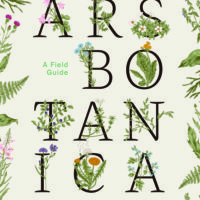I was on a cold, sunny bench when a friend told me about Tim Taranto’s debut memoir, Ars Botanica. Looking back, I can’t remember if she told me by phone or in-person. What I do know is I was about seven weeks pregnant, stuck in that time when I was sure I was pregnant but it was too soon to tell anyone. Stuck in that time between winter and spring. I was exhausted. Taranto describes these early weeks perfectly. He says, “After we knew for certain she was pregnant, her morning sickness took on the characteristics of a horrible flu.”
When that friend told me about Ars Botanica, I wasn’t sure I wanted to read it. The pitch is difficult: a man recounts his love for his unnamed ex-girlfriend through letters to their unborn child. But I want to pause here and breathe into this synopsis. It is true, yes, the story is as described. But the weariness I felt hearing it the first time was off-base. I was wrong to assume this would be a guilt-ridden story about abortion. This lovely story is really guiltless. It is stitched together with so many smiles, a fair amount of earned heartache, and lots and lots of love. It asks to be treasured through every page, and it is.
This is clear to me from the very second page, where Taranto says, “What’s the difference between living and thriving? Before I met her I was living.” Before her, he loved to limbo, study dinosaurs, and grade papers in the sauna. But when he met her, he was “filled with a warm repose, how a houseplant must feel when moved to a sunny sill.” Throughout the narrative, I fall in love with her, too.
She is outdoorsy and adventurous. She’s rooted in nature, but loves Lord of the Rings and baking pies. She is his “Trap Queen.” She laughs heartily and plays the harmonica. Very early in her pregnancy, before she even realizes her period is late, she gets into a gnarly bicycle accident that shatters her collarbone. The images of her in the sling are so vulnerable, goofy, sad.
When I reflect on the early days of my pregnancy, I recount certain moments obsessively like Taranto does. For me, one is sitting on a park bench. Remembering the weather but not if I was alone. For him, one moment is when she flies off the bike and into the dirt. Other moments include her warmth, her glow, and her slow, intimate pace. He writes,
…the ultrasound technician told her your exact age. “Nine weeks, six days,” she said. We scrolled back through the photos on my phone: cartoons we’d drawn, walks we’d taken in the prairie through sunflower and bee balm, fruits and fungi we’d foraged, meals cooked, sunsets viewed, fireworks, a video of a snail crawling over her hand.
To keep the memoir from losing itself in these images, Taranto cuts through the more emotional sentiments with direct information. Early on, he hints at a thesis for the book:
When she communicated her desire to terminate the pregnancy, I was with her, it was what I wanted, too. When she communicated her desire to terminate the relationship, I pulled my hat over my eyes and sank into the sofa.
He spends the majority of the next pages citing evidence for these claims, and he does so convincingly through curated episodes of their romance.
There is something this narrative does really well, and it is that it doesn’t make a case for or against abortion. It doesn’t really try to, as it tracks a very specific account of an experience. It shares specific thoughts about a specific relationship. In the end, I am not left with an agenda, but I am left with some things to consider.
In the story, a close friend of the couple’s announces she is pregnant, and she is just about as far along as the central woman. There is, justifiably, some psychological spin-out over this. But as I read this, I consider how an early ultrasound will show a woman who wants to have a baby just that: a baby. The same ultrasound can show a different woman, one who does not want to have a baby, an undeveloped group of cells. A lima bean, as put in Ars Botanica. One woman’s perception is based in excitement. The other’s is based in dismay. The two women are looking at a similar structure and feeling completely different things. Both women are right.
There is no way to classify a response to pregnancy. It is what it is, which is why people find consolation in naming their phantoms. In this case, the phantom is named Catalpa.
The beauty of taxonomy literally staples the book together. On one side, an illustrative imprint of a plant, fossil, or photograph. On the other, a title of the species, accompanied by a small lyric, poem, or excerpt. The genre is hybrid in this way, making the book a “field guide to loss.” At times, the book feels like a pamphlet in a nature preserve, a notebook to write impressions of different species. Taxonomy is also significant to the couple’s relationship. Together, they collect and classify fossils and plants. To my delight, the impressions are already written for me. The structure gives a good workout: a chance to ruminate on the emotional and learn about the literal.
The structure is also successful in giving a childlike pleasure to information and subjects that may otherwise be daunting. The book’s layout isn’t alone in this, however. Taranto’s delivery throughout is totally digestible and relatable. Part of the irresistibility I mention is his forthright self-deprecation, without seeming needy. He’s not someone to feel sorry for, but he is someone to want more from.
The story is easy to tear through. One may have to remind herself that white space in the pages is not a cue to go faster, but maybe a means to slow down and pause.
In addition to depictions of their relationship, Taranto is honest and delicate when describing his own body. He discusses his alopecia. The physicality of it, as well as the experience of having it. He is blunt about what people say and how he responds. He says, “A second-grade student told me she liked me better when I had eyebrows. I told her I liked me better then, too.”
The melancholic frankness of these descriptions makes his connection with his former lover even more special. He rarely wears a hat around her. Sometimes he thinks his hair will grow in because of her. While reading, I couldn’t help but wonder what she thinks of this book, and how her own memoir would add to the narrative. At the relationship’s end, I miss their love, but I miss it in an understanding and forgiving way. As someone in the book says, “Statistically speaking, couples usually don’t make it through these sorts of things.”
It may be true that this kind of loss is hard for lovers survive, but Ars Botanica gives the reader a beautiful space to question why that is.




